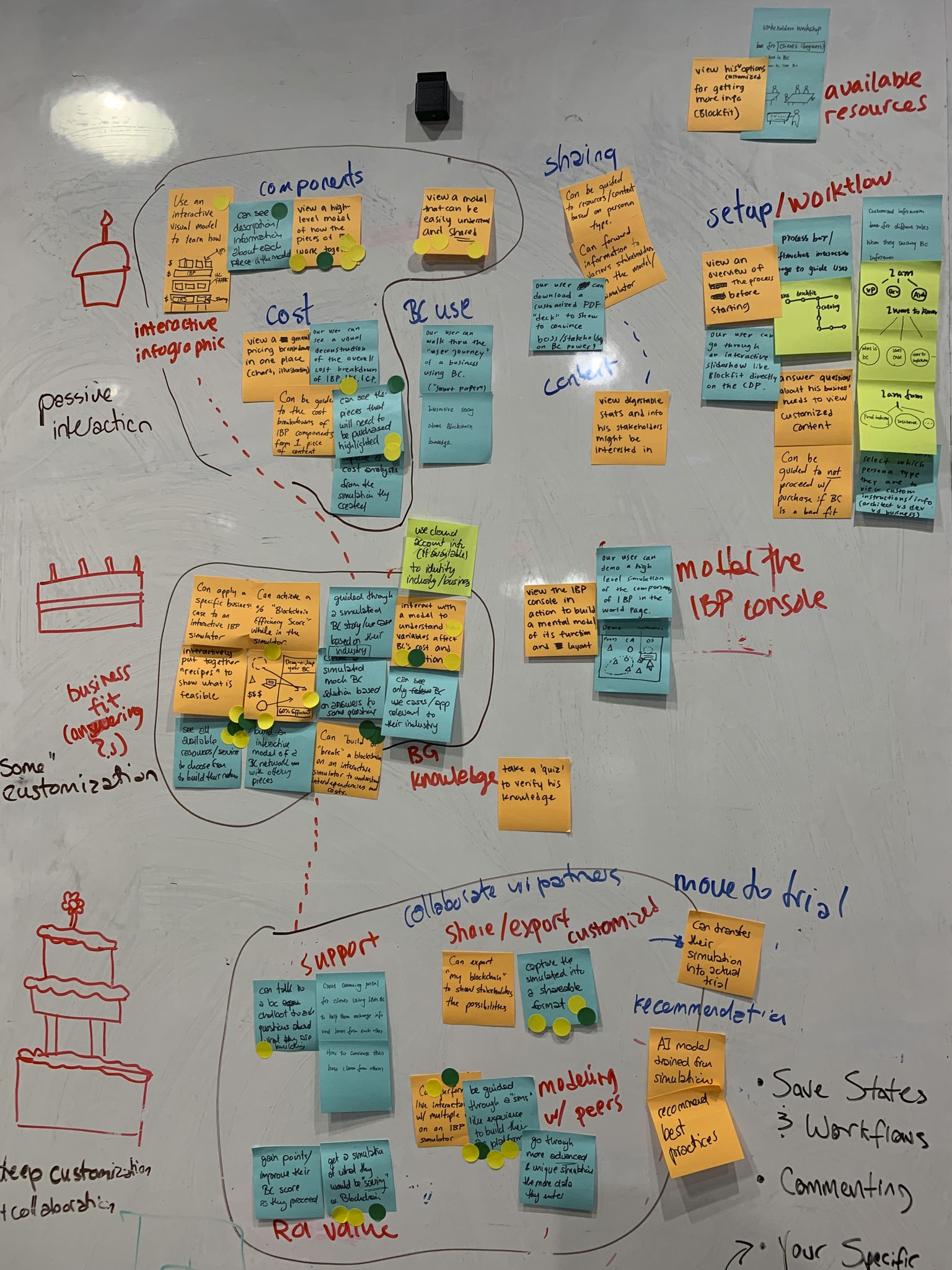Visual-driven educational and getting started experience for IBM Blockchain.
Overview
Born from an IBM "hackathon" to promote cross-team collaboration, our team of strangers quickly adapted to help the IBM Blockchain team tackle one of their users' major pain points: Understanding the cost of ownership of blockchain. We prototyped and pitched to the client team and design leadership.
My role
Collaborate with designers, researchers, and content designers to pitch a solution
I led many of the mapping activities, created the final pitch deck, and delivered the presentation to leadership
User interviews
Journey mapping
Personas
Affinity mapping
Sketching
Hi-fi prototyping
Usability testing
The client team approached us with a challenge in response to the large learning gap between grasping the bare minimum concept of blockchain and understanding how it might be able to provide tangible value to a company.
They had 2 requests of the solution we delivered:
1. Make it self-service, because our support folks are already swamped; and
2. Make it sexy.
They informed us that the target user in this case shall be called Alan the Solutions Architect.
He has a business need that may be solved by using IBM Blockchain. He has deep technical knowledge but is new to blockchain, and would like to try it out before pitching to his team.

I spent the first week building domain knowledge by interviewing sponsor users and doing secondary research. I used that knowledge to map out the as-is flow for users to discover, evaluate, try/buy, install, and get started with the IBM Blockchain Platform.

We uncovered two major pain points from this process:
1. Cost was incurred at various parts of the flow. The only warning that this would be the case was hidden on a detail page that many users probably would not read all the way.
2. The user would need to bounce between two IBM services to purchase the service, set up the cluster, and then deploy the service to the cluster. According to previous research, the cluster set up page does not have a link back to the service set up so prospective users would often be lost at this step.
Translated into user needs, that would mean:
1. Users need to understand which steps in the setup process cost money
2. Users need a single flow, or passing between the two portals to be less clunky.
The solution should help users understand in general where cost occurs and how the elements are linked together. Getting an exact quote for their use case is not in scope.
With that, I co-facilitated brainstorming and organizing our favorite ideas into a roadmap based on estimated feasibility.
Near term was simple, passive interaction with general info, like a static tutorial.
Mid-term answered questions about business fit, such as a customized tutorial based on a quiz or series of questions.
Long term was a deeply customized experience with collaboration, such as a sandbox blockchain conceptual simulator.
Presenting this to the client team, they seemed to like the mid-term solution the most.

The team spent the next few days in deep discussion on how to bring this custom tutorial to life. Combining several of our big ideas, we knew we wanted to make a visual model paired with explanations and a series of questions that would customize the model. We began to sketch, vote, and sketch some more.
The outcome was a step-by-step, visual-driven onboarding experience to demonstrate the high-level concepts and interdependent pieces of the IBM Blockchain Platform (IBP) for a variety of knowledge levels.
While going through the experience, a viewer can configure parts of the visualization, such as how many peers they would want in their network or if they expect to have multiple organizations in their network. The budget bar at the bottom left indicates how the price might be affected if they create those configurations. Prospective users can easily turn their curiosity into commitment by exporting a configuration file.

The user can see the model being built and connected as each component is introduced.

At any step in the flow, the user can learn about the elements and changes being introduced.

User can dive into details, or skip over things they don't need.

Users can learn about the factors that contribute to the cost of blockchain ownership.
Use the model to collaborate on a blockchain configuration that can be exported to json and imported directly to the ibm blockchain platform.
Patina Network: Leadership, Workshops, and Strategy
How I led a series of workshops that transformed the vague ideas into an actionable roadmap, already benefitting dozens of students in just 4 months.
Service Design
Visual Design
Management
Adobe Commerce Storefront
Adobe's new e-commerce storefront framework designed obsessively with modularity and customizability.
UX Design
Design Systems
Scalability





